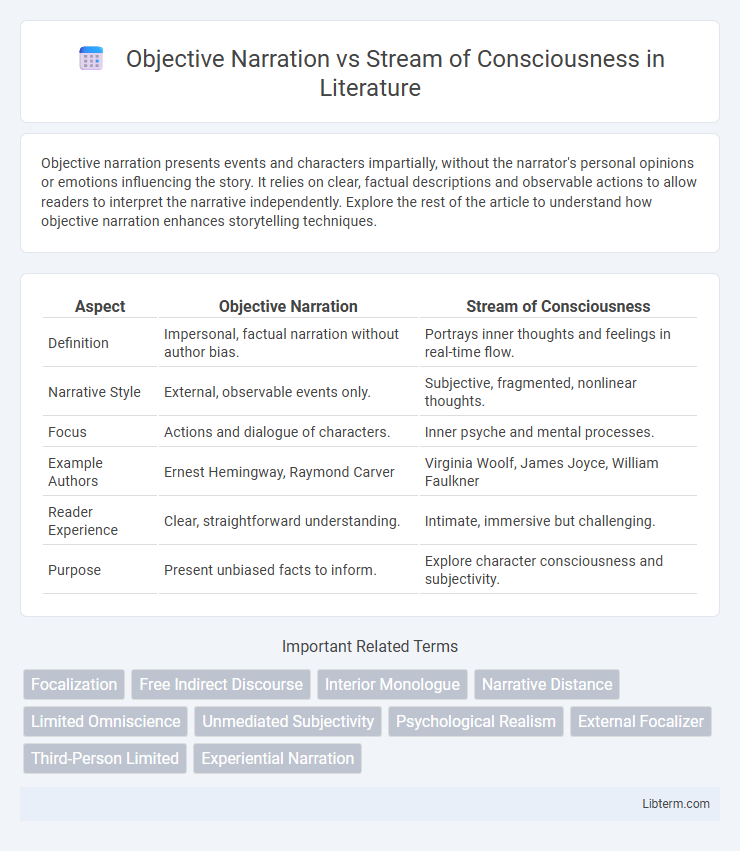Objective narration presents events and characters impartially, without the narrator's personal opinions or emotions influencing the story. It relies on clear, factual descriptions and observable actions to allow readers to interpret the narrative independently. Explore the rest of the article to understand how objective narration enhances storytelling techniques.
Table of Comparison
| Aspect | Objective Narration | Stream of Consciousness |
|---|---|---|
| Definition | Impersonal, factual narration without author bias. | Portrays inner thoughts and feelings in real-time flow. |
| Narrative Style | External, observable events only. | Subjective, fragmented, nonlinear thoughts. |
| Focus | Actions and dialogue of characters. | Inner psyche and mental processes. |
| Example Authors | Ernest Hemingway, Raymond Carver | Virginia Woolf, James Joyce, William Faulkner |
| Reader Experience | Clear, straightforward understanding. | Intimate, immersive but challenging. |
| Purpose | Present unbiased facts to inform. | Explore character consciousness and subjectivity. |
Understanding Objective Narration
Objective narration presents events and characters without revealing internal thoughts or emotions, offering an unbiased and external viewpoint. This narrative style relies strictly on observable actions and dialogue, maintaining neutrality and allowing readers to interpret motivations independently. Understanding objective narration is essential for analyzing texts where authorial impartiality shapes the story's realism and credibility.
Defining Stream of Consciousness
Stream of consciousness is a narrative technique that aims to depict the continuous flow of a character's thoughts, feelings, and sensory experiences in an unfiltered and often nonlinear manner. Unlike objective narration, which presents events and dialogue externally and without internal commentary, stream of consciousness immerses readers directly into the subjective, fragmented mental processes of the character. This method captures the complexity of human cognition, revealing inner conflicts and spontaneous associations that shape a character's consciousness.
Key Features of Objective Narration
Objective narration presents the story through impartial, factual descriptions without revealing characters' inner thoughts or emotions, emphasizing external actions and dialogues. It relies on observable details, allowing readers to interpret characters' motivations independently and maintain an unbiased perspective. This narrative style is commonly used in journalistic writing and classic literature to create a clear, straightforward account of events.
Characteristics of Stream of Consciousness
Stream of consciousness is a narrative technique that presents a character's thoughts, feelings, and sensations in a continuous flow, often disregarding conventional grammar and punctuation to mimic natural thought patterns. This style immerses readers directly into the protagonist's mind, capturing the chaotic and fragmented nature of inner experiences, usually incorporating interior monologue and free association. Unlike objective narration, stream of consciousness emphasizes subjective perception and emotional depth over external, observable events.
Historical Origins and Influences
Objective narration, rooted in the 19th-century Realist movement, emphasizes impartial and detailed description without revealing characters' inner thoughts, influenced by authors like Gustave Flaubert. Stream of consciousness, emerging in the early 20th century, captures the unfiltered flow of a character's thoughts and feelings, inspired by psychological theories and pioneered by writers such as James Joyce and Virginia Woolf. These narrative styles reflect shifts in literary focus from external reality to internal experience, shaped by historical changes in art and psychology.
Advantages of Objective Narration
Objective narration offers a clear and unbiased presentation of events, allowing readers to interpret the story without authorial influence. This style enhances credibility by maintaining factual accuracy and emotional neutrality. Its straightforward approach aids in creating a universal understanding, making complex narratives more accessible and engaging.
Benefits of Stream of Consciousness
Stream of consciousness narration allows readers to experience a character's inner thoughts and emotions in real-time, creating a deeply immersive and authentic connection. This technique captures the complexity and randomness of human cognition, providing nuanced insight into motivations and psychological states. It enhances character development by revealing subconscious drives and fragmented perceptions often absent in objective narration.
Common Challenges for Writers
Writers often struggle with maintaining clarity and coherence when shifting between objective narration and stream of consciousness, as the former demands impartial reporting while the latter immerses readers in a character's internal thoughts. Balancing vivid, introspective details without overwhelming the narrative or confusing the reader poses a significant challenge. Achieving seamless transitions between external events and subjective experiences requires careful control of tone and pacing to preserve narrative engagement.
Notable Literary Examples
Objective narration employs an impartial, external viewpoint famously utilized in Ernest Hemingway's "Hills Like White Elephants," where the narrative remains detached from characters' inner thoughts. In contrast, stream of consciousness delves deeply into characters' mental processes, exemplified by James Joyce's "Ulysses" and Virginia Woolf's "Mrs Dalloway," capturing fragmented, nonlinear thoughts. These narrative techniques distinctly shape readers' engagement with character psychology and storytelling structure.
Choosing the Right Technique for Your Story
Objective narration offers a clear, unbiased viewpoint, ideal for stories requiring factual clarity and distance between reader and characters. Stream of consciousness provides intimate access to a character's thoughts and feelings, enhancing emotional depth and psychological complexity. Selecting between these techniques depends on narrative goals: use objective narration for external events and multiple perspectives, while stream of consciousness suits introspective, character-driven tales.
Objective Narration Infographic

 libterm.com
libterm.com